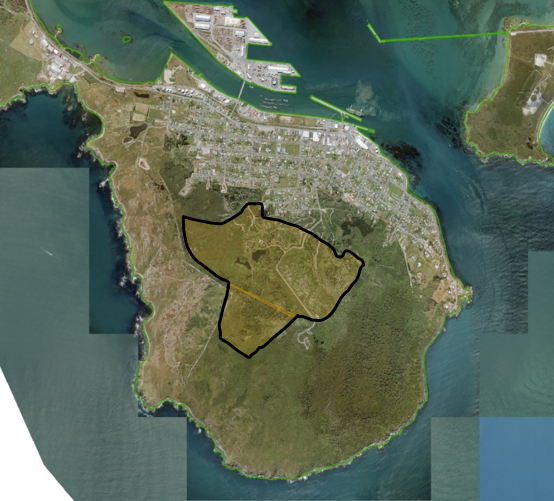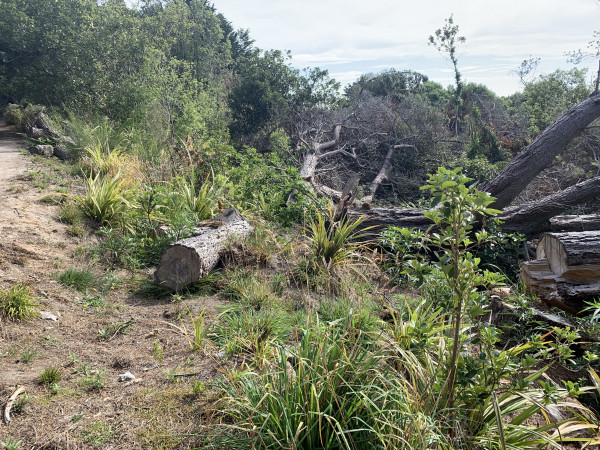Motupōhue (Bluff Hill)[1] is located at the southern tip of Te Wai Pounamu the South Island, in an area known by Ngāi Tahu as Awarua. The hill encompasses approximately 960 hectares of land in total, and is a significant site of cultural, recreational and ecological importance.
Today there are multiple owners and managers of land within the maunga: The town of Bluff takes up 221 hectares (ha), farmland 118 ha, and the Isthmus 122 ha. The DoC Scenic Reserve covers 204 ha and Invercargill City Council Reserves 295 ha.
Once known for deafening birdsong, Motupōhue is home to declining at-risk, nationally vulnerable and endangered bird species[2]: black-backed gull (Karoro), little blue and yellow penguins (Kororā and Hoiho), Stewart Island shag (Koau), mainland sooty shearwater (Tītī), red-crowned parakeet (Kakariki), South Island rifleman (Titipounamu), fernbird (Mātā), Kākā and New Zealand pigeon (Kukupa/Kereru).
Many have been in decline due to pest predators and the degradation of native bush.
Within the 295 hectares on the maunga owned by Invercargill City Council (ICC), a section was used for plantation forestry for several decades, until being cleared for the last time in 2013. There remained the need to remove resulting wildings. Over the years ICC and Bluff Hill Motupōhue Environment Trust volunteers removed several thousand small conifers, though they were only able to deal with small stems. Removing larger mature trees would need specialist help and funding.
The value of wilding control work on Motupōhue, while it has economic benefits for the local community through tourism and recreational uses, is beyond what can be quantified in financial terms.
Motupōhue is recognised as Tōpuni in the Ngāi Tahu deed of settlement with the Crown (1998), reflecting the mana of the site and recognising the role of the people of Ngāi Tahu as kaitiaki (guardians of wellbeing) and manawhenua (holding customary authority, rights and responsibilities for the life of the natural environment and resources in their rohe).
In Ngāi Tahu legend, Motupōhue is Te Tau Rapa o te Waka o Maui (the stern of Maui’s waka – where the chiefs stand, where it is steered from). l In cultural history it was the lookout site at the very south of Te Waipounamu, connected with Te Punga o Te Waka a Maui (the anchor of Maui’s waka) the other lookout site in the area – across the strait on Rakiura (Stewart Island). It is also a burial ground for chiefs, including Ngāti Mamoe leader, Te Rakitauneke.
This makes it a sacred place of extra special historical significance and equally treasured by today’s generations of Ngāi Tahu, including the tamariki at the marae based Kohanga Reo operated at Te Aroha Marae on the maunga
Tamariki attending Te Rourou Whakatipuranga O Awarua, are growing up with the maunga, as a part of their past present and future. It’s a place to be connected with their whakapapa, and where they learn about biodiversity and conservation. They are taken up the hill to learn about the native ecosystems, to participate in protecting the maanu (birds) by trapping pests, and to gather kai.
Mātauranga Māori connects whenua and whanau. When the land is damaged, the people are damaged. When exotic species invade the whenua, they displace native flora and fauna and the mana of whanau is impacted. Clearing wilding pine helps to restore that mana.
In 2018 the Council spent about $30,000 to boost the wilding pine removal process.
“We realised it was going to be a big job, and that it would take a long time to finish,” says Kate Gough, then Council Team Leader Parks Environmental Reserves.
In 2019, Invercargill City Council applied for and received a Community Partnership Projects funding grant of $200,000 from the National Wilding Conifer Control Programme, via Environment Southland. Council also providing funding and staff time to make sure the project was completed.
In total, the wilding control work funded by the National Wilding Conifer Control Programme covered around 127 hectares – the area outlined in black on the aerial image below.

Image from National Wilding Conifer Control Programme’s Wilding Conifer Information System, provided by Toitū Te Whenua Land Information New Zealand
This support to clear much of the wilding infestation coincided with the Bluff Hill Motupōhue Environment Trust (BHMET) receiving funding to expand its predator control work, via the Department of Conservation (DoC) Jobs for Nature Community Conservation Group funding.
“That alignment of the two sources of funding was very fortunate and is allowing a real acceleration of habitat restoration across the whole of Motupōhue,” said David Swann, BHMET Project Manager.
Bluff Hill Motupōhue Environment Trust (BHMET) was formed in early 2008 by members of Runaka Awarua o Ngāi Tahu, and other concerned Bluff residents. Their passion for the protection and restoration of Motupōhue and concern about pests were galvanised when adult tītī were found killed by a stoat.
Estelle Pera-Leask, Chair of BHMET and member of Runaka Awarua o Ngai Tahu relates the feeling of the community at the time “We’ve lost so much, we can’t afford to lose anymore… There are penguin colonies, tītī, and other species you won’t find in many other places – it’s a no brainer.”
Despite meeting initial scepticism for what they hoped to achieve, BHMET eventually entered into a Management Agreement with the Department of Conservation (DOC) and the Invercargill City Council (ICC) to undertake environmental restoration in the Bluff Hill area.
The Trust is supported by volunteers (including its Trustees) to carry out pest control, management and administration duties and receives generous and critical support, including funding, from other agencies and local organisations for various aspects of the restoration work.
Soon after setting out towards its vision, the Trust received in 2009 its first of numerous environmental and community awards recognising its mahi.
Trapping lines with more than 2000 pest control devices stretch for over 75 kilometres around the whole hill and the numbers are staggering. Predator catches in one month can count in the dozens for multiple predator species, mostly rodents and mustelids. A record was set in 2012 for 39 possums in one month.
While removing pest animals and overshadowing wildings helps make space for native species to re-establish, the birds the maunga was once known for need food sources and habitat to safely live and breed, explains David Swann, BHMET Trustee & Project Leader. To this end, the Trust established its own nursery to re-populate the whenua with plants that belong there and support its treasured inhabitants.
Seeds in the hundreds of thousands are gathered from the maunga, sown, nursed and re-planted - replacing natives damaged by pests, and the spaces now cleared of invading wildings.
“What was the wilding pine mess will now be native vegetation,” explains Estelle.

Photo supplied by Bluff Hill Motupōhue Environment Trust showing new native growth already flourishing on Motupōhue Bluff Hill, where invasive wildings have been removed
With the bulk of wildings mostly cleared, though some remain, the potential damage of a wilding-fuelled fire getting out of control is reduced, and fresh water from aquifers and underwater springs (natural awa) can be purified by running through restored native bush. Kōura (freshwater crayfish) and tuna (eels) are now able to thrive.
With Jobs for Nature funding the trust is involved in a major habitat restoration on that part of the hill. David Swann, says “in the few months that have passed, the extent of native regrowth is staggering and is a joy to see for the trust and the community.”
Native birds including Kākā and kereru, that were unable to thrive in the pine forest, have been returning to the area. The South Island robin (Kakaruwai) has been translocated back to the hill now that their food sources are available again. These birds only establish on podocarps full of invertebrates and berries. Maximising area available for podocarps is also important for the movement of ground dwelling birds as well, such as kiwi when they are re-introduced.
Once the native bush regenerates (up to 15 years) it will outcompete wildings and gorse stopping them from re-establishing, but, David says, “in the short term, as long as any wilding pine remains, the threat remains for any native bush still in its regenerating phase.”
The mahi to rid Motupōhue of the last of the outlying wilding pines will continue for some time, led by Invercargill City Council.
Kate Gough, Invercargill City Council, says in 2022 “It is great to have made some really positive progress on the hill, but this isn’t the end. Seedlings and small pines that have been missed will show up over the next few years, so we now need to keep monitoring this and remove them as they’re found. So yes, we have got a great head start to the wilding pine removal, but the job is not done yet!”
Kate Gough, Invercargill City Council, has great respect for the Trust’s commitment and achievements.
“It’s wonderful to work with a community that has real drive and a clear vision of what they are wanting to achieve. Bluff has so much potential and the work that the community are putting into it to make the place shine is humbling and is a journey that I feel privileged to be able to be part of.”
Estelle, David and the Trust see a restored Motupōhue Bluff Hill as an important site to support genetic diversity of Kākā and Kereru. It forms part of an essential corridor for flocks of kereru to travel, feed and rest (and next), between Rakiura, Motupōhue and Fiordland – supplying important variety in food sources, and allowing flocks to inter-breed, enhancing healthy genetic biodiversity.
The members and supporters of the Bluff Hill Motupōhue Environment Trust have a long-term vision for the restoration of whole of the maunga. This includes plans to reintroduce Tīeke (saddleback) in 2023 from one of the nearby titi islands and reintroduce kiwi by 2030.
For Estelle and the people of Ngāi Tahu ki Murihiku, particularly Runaka Awarua, it’s about restoring the mana to the area. “It (the restoration occurring) means everything to us – the mana and mauri (life force) of that hill is restored… “We have native forest that people can visit. Visitors rave about what they see. We’re super proud of it”.
For more information visit https://www.motupohue.nz/
[1] From Kā Huru Manu, cultural atlas published by Te Runanga o Ngāi Tahu:
Motupōhue (Bluff Hill) is the prominent forested hill located behind Bluff township. Motu in this case means “a clump of trees”, and pōhue is the native convolvulus (Calystegia sepium). In accordance with his dying wish, the celebrated Kāti Māmoe leader Te Rakitauneke was buried on Motupōhue with his face to the rising sun, so that he could overlook Murihiku (Southland). Te Rakitauneke’s saying was: “Tāpuketia au ki Motupōhue kia mārama ai tāku titiro ki Te Ara-a-Kiwa” — “Bury me upon Bluff Hill so that I may gaze upon Foveaux Strait”.
[2] Ngāi Tahu names for Taonga species Ngai Tahu Settlement | Beehive.govt.nz